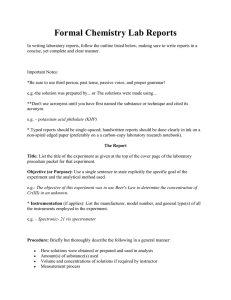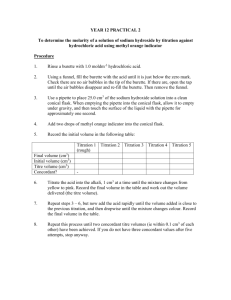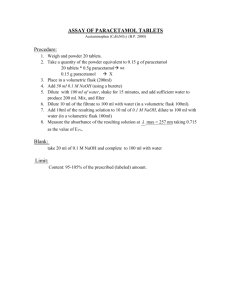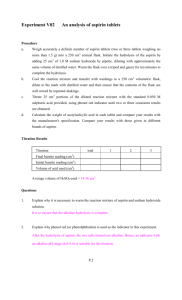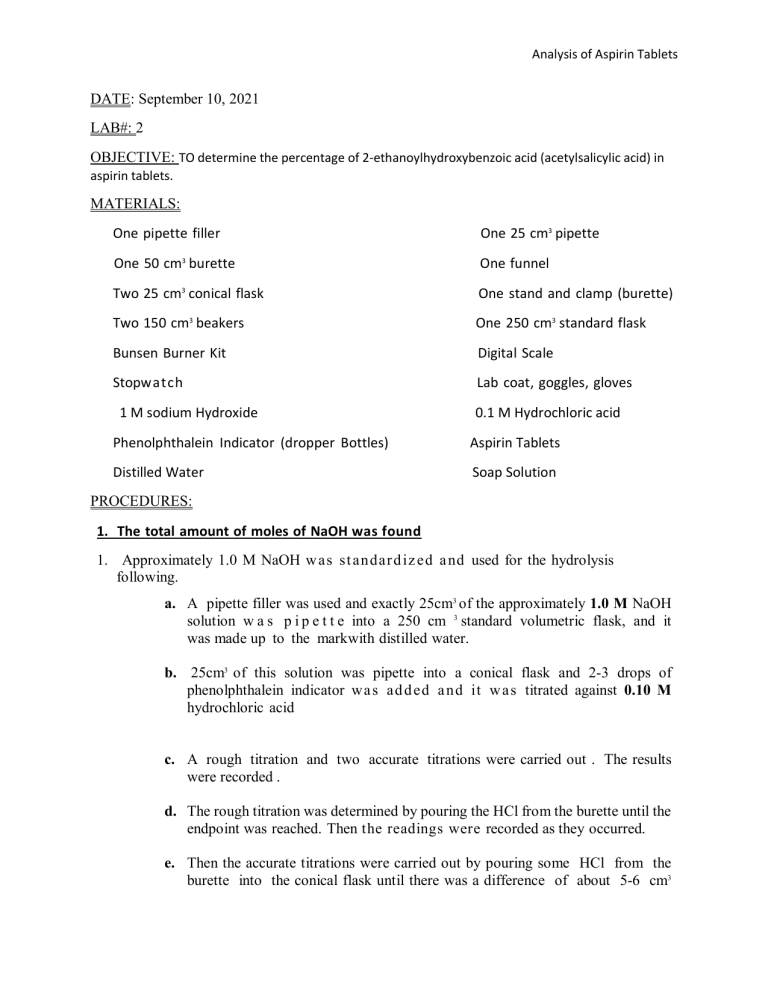
Analysis of Aspirin Tablets DATE: September 10, 2021 LAB#: 2 OBJECTIVE: TO determine the percentage of 2-ethanoylhydroxybenzoic acid (acetylsalicylic acid) in aspirin tablets. MATERIALS: One pipette filler One 25 cm3 pipette One 50 cm3 burette One funnel Two 25 cm3 conical flask One stand and clamp (burette) Two 150 cm3 beakers One 250 cm3 standard flask Bunsen Burner Kit Digital Scale Stopwatch Lab coat, goggles, gloves 1 M sodium Hydroxide 0.1 M Hydrochloric acid Phenolphthalein Indicator (dropper Bottles) Aspirin Tablets Distilled Water Soap Solution PROCEDURES: 1. The total amount of moles of NaOH was found 1. Approximately 1.0 M NaOH w as st andar d iz ed a nd used for the hydrolysis following. a. A pipette filler was used and exactly 25cm3 of the approximately 1.0 M NaOH solution w a s p i p e t t e into a 250 cm 3 standard volumetric flask, and it was made up to the markwith distilled water. b. 25cm3 of this solution was pipette into a conical flask and 2-3 drops of phenolphthalein indicator wa s ad d ed a nd it w a s titrated against 0.10 M hydrochloric acid c. A rough titration and two accurate titrations were carried out . The results were recorded . d. The rough titration was determined by pouring the HCl from the burette until the endpoint was reached. Then the readings were recorded as they occurred. e. Then the accurate titrations were carried out by pouring some HCl from the burette into the conical flask until there was a difference of about 5-6 cm3 Analysis of Aspirin Tablets from the endpoint base that was the rough titration. Then the end point was reached by adding pour drop wise. f. When the titrations were finished the solution from the standard flask was discarded. 2. The aspirin was Hydrolyzed as follows. a. Between1.3g and 1.7g of the Aspirin tablets was accurately weighed and placed into a dry and clean conical flask. The mass of aspirin tablets was recorded. (The zero button on the scale was pressed so that the weight of the conical flask was not taken. b. A safety filler and a pipette were used to pipette 25cm3 of the approximately 1.0 M NaOH onto the tablets, then about the same volume of distilled water was added. c. The mixture was gently simmered for 10 minutes to hydrolyze the acid. A typing sheet was ffolded lengthwise for about 4-5 folding. d. The mixture was cooled over the faucet and all the solution from t he conical flask was t r ansfer r ed with washings to a 250 cm3 standard flask and made up to the mark with distilled water. 3. The unused NaOH after the hydrolysis was founded a. 25cm3 of the hydrolyzed solution was pipetted from the standard flask into a conical flask. b. 0.10 M hydrochloric acid was titrated against the solution from step 3-a. phenolphthalein indicator was used. 2-3drops of Phenolphthalein indicator were placed into the conical flask which contained the hydrolyzed solution. c. The experiment was ran about three times until two consecutive readings were obtained. The titration results were recorded. DATA/RESULTS: Description Initial Reading Final Reading (cm3) Volume of HCl (cm3) Rough 0 26.6 26.6 First Titration 0 25.5 25.5 Second Titration 0 25.5 25.5 Third Titration Average 25.5 TABLE 1: SHOWING THE TITRATED SODIUM HYDROXIDE WITH HYDROCHLORIC ACID Analysis of Aspirin Tablets Description Initial Reading Final Reading (cm3) Volume of HCl (cm3) 0 11.4 11.4 Rough 11.4 21.2 9.8 First Titration 21.2 31 9.8 Second Titration Third Titration 9.8 Average TABLE 2: SHOWING THE TITRATED HYDROLYZED TABLETS WITH HCL CALCULATIONS: Analysis of Aspirin Tablets DISCUSSION AND CONCLUSION Back titration is a titration done in reverse; instead of titrating the original sample, a known excess of the standard reagent is added to the solution, and the excess is titrated. A color indicator is commonly used. The neutralization is indicated by a color change due to the use of phenolphthalein. The mixture was simmered carefully and gently during the hydrolysis in order to make sure that there is a complete hydrolysis of all the acetylsalicylic acid in the tablets by the sodium hydroxide. It is not encouraged to boil the solution vigorously because if the temperature increases the liquid can spill out from the conical flask. Washings should be transferred carefully to the conical flask to ensure that all the contents are transferred to the standard flask. All the contents should be carefully transferred to the e 250 cm 3 standard flask because if any of contents spill the hydrolyzed solution will be affected causing the final result to be inaccurate. Aspirin is an ester which can easily participate in a hydrolysis reaction. So easily that in a traditional titration with NaOH, the alkaline conditions break it down, resulting in errors in analysis. Its water solubility is additionally low. To resolve these problems, Aspirin is totally hydrolyzed to acetic acid with excess NaOH. The NaOH in excess is then titrated with standardized acid (HCL) to calculate the quantity used in the reaction with Aspirin and thereby the number of drug within the flask. The acid in question is acetylsalicylic acid. The mass of acid normally found in an aspirin tablet is 0.325g. In the experiment it was found that 0.1413% of acid was in the aspirin tablet and the percentage by mass of the aspirin acid per tablet is 36.46%. This resulted IN a 56.5%percentage error. The experimental mass of acid in the tablets differed from THE theoretical value because the aspirin tablets have many impurities that may affect the accuracy of the calculations. Aspirin is used as an analgesic and an antipyretic Analysis of Aspirin Tablets drug. This is due to it being able to reduce pain, fever and inflammation. Analgesic drugs help to reduce pain and antipyretic drugs reduce fever and inflammation. The other components of aspirin include the following: corn-starch, powdered cellulose and triacetin. Aspirin can be prepared by chemical synthesis from salicylic acid by acetylation with acetic anhydride. LIMITATIONS, SOURCE OF ERROR AND ASSUMPTIONS: The aspirin tablets had many impurities. The burette may have not been accurately at eye level . Assuming the concentration of the HCl was 0.1M. CONCLUSION: The percentage of 2-ethanoylhydroxybenzoic acid (acetylsalicylic acid) in aspirin tablets is 36.46% REFERENCE: HACHERO.Z. (2015). QUANTITATIVE ANALYSIS OF SODA ASH BY DOUBLEINCATOR TITRATION. RETRIVED SEPTEMBER 15, 2021, FROM SCRIBD.COM. SITE: https://www.scribd.com/document/282892015/ATQ-E5-chem-28 SMITH.W. (2021). BACK TITRATION. RETRIVED SEPTEMBER 15, 2021, FROM CHEMEUROPW.COM. SITE: https://www.chemeurope.com/en/encyclopedia/Back_titration.html
